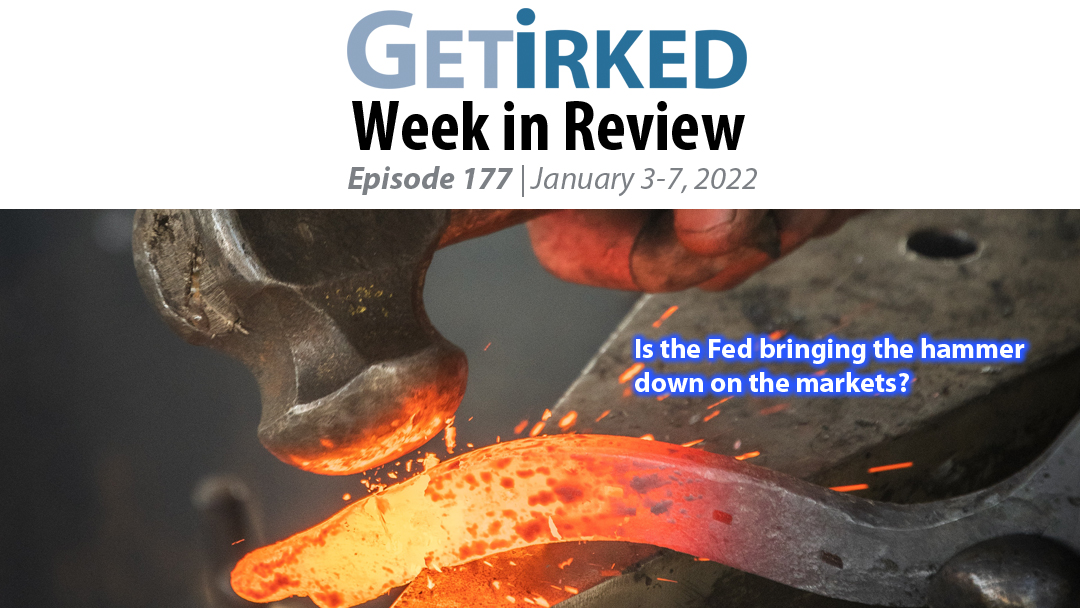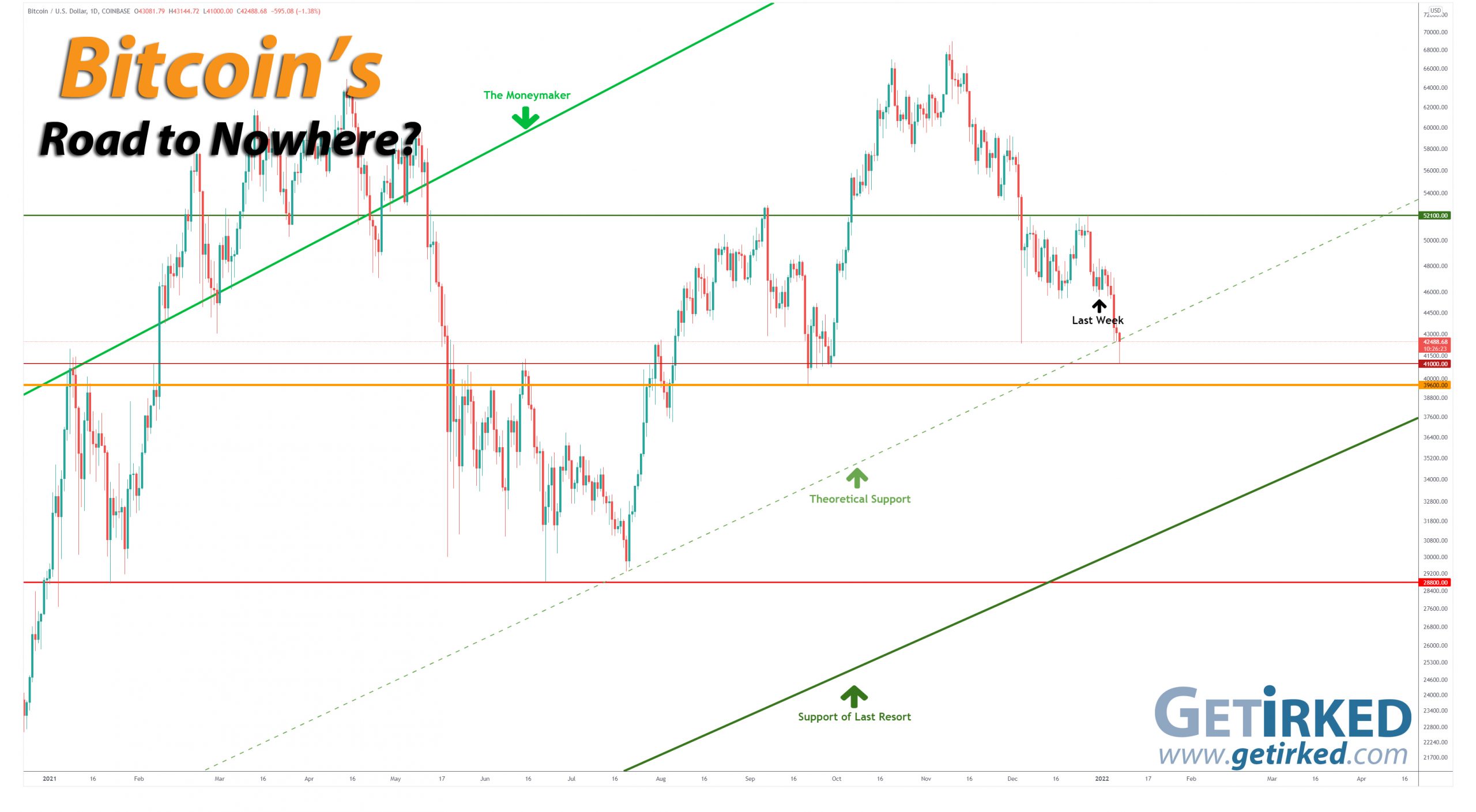Summing Up The Week
It’s official, Santa has left Wall Street. The Santa Claus Rally, which often continues a few days into the start of the new year, ended when the Federal Reserve Bank showed its plans to take the punch bowl of free liquidated money away from the markets this week.
Believing they see a stronger economy and inflation that needs to be defended against, the Fed announced plans not just to taper and increase interest rates, but also to decrease its pre-existing balance sheet. And, boy, did the markets not like that!
Let’s take a look at the news that moved the markets this week…
Market News
Over 1M new daily U.S. Covid cases reported
On Tuesday, COVID-19 once again dominated headlines as the U.S. reported over 1 million new daily COVID cases from the omicron variant, reported CNBC. Despite the record number of new cases, the markets took the news in stride, likely discounting the less lethal nature of the new variant despite its high level of contagion.
The report came on the heels of news that airlines had canceled more than 15,000 flights over the past few weeks due crew members contracting the virus. Once again, despite the short-term negative news, airline stocks actually rallied since the markets look through current events to see future demand returning to the beleaguered travel sector.
ADP reports 807K new private jobs in December
On Wednesday, payroll processor ADP reported private job growth totaled 807,000 in December, more than doubling expectations, reported CNBC. New jobs grew across all sectors with the travel/hospitality sector coming in highest with 246,000 new positions. Analysts pointed to the decline in Delta variant as the reason for increased hiring but also warned that the Omicron variant’s impact is not reflected in the report.
“December’s job market strengthened as the fallout from the Delta variant faded and Omicron’s impact had yet to be seen,” said Nela Richardson, ADP’s chief economist. “Job gains were broad-based, as goods producers added the strongest reading of the year, while service providers dominated growth.”
Fed preparing to reduce balance sheet
On Wednesday, the markets freaked out when the minutes from the Federal Reserve meeting in December showed that the Fed is planning to cut the amount of bonds it’s holding, reported CNBC.
Wait. Didn’t the Fed already announce this?
Actually, no. The Fed did begin tapering – or reducing its bond-buying program – back in November of last year, however, most analysts didn’t think the Fed was planning to reduce the bonds it already bought. Analysts believed the Fed would keep its balance sheet – the assets it has already purchased – intact for a longer period of time before selling anything off.
Instead, the Fed’s meeting minutes showed that the majority of bank chairs felt it was time to start selling off assets following the first interest rate increase in Q2 of 2022.
Naturally, this news was unexpected so the entire market sold off following the release of the minutes.
Only 199K new jobs in December vs 422K expected?!
On Friday, the Labor Department’s December jobs report disappointed investors as the economy only added 199,000 new jobs in the month compared to the expected 422,000, reported CNBC. An odd bright note is that unemployment fell to 3.9% versus the expected 4.1% rate.
Analysts blamed the surge in Covid cases for the weak jobs number, with the highest sector for job creation mirroring ADP’s earlier report as leisure and hospitality added 53,000 new jobs followed by professional/business services at 43,000 and manufacturing at 26,000.
Next Week’s Gameplan
The old stock adage “don’t fight the Fed” has been in effect in a big way for years. Now that the Fed has turned hawkish rather than dovish, the adage still applies. On the way up with a dovish Fed, that means not shorting or betting against the market.
With a hawkish Fed, that means either taking bearish bets or widening price gaps between buys in long-term positions (obviously, I take the latter strategy since I don’t short). As always, the simplest approach is to have two plans – one for when stocks go up, and another for when stocks go down – and stick to them.
This Week in Play
Stay tuned for this week’s episodes of my two portfolios Investments in Play and Speculation in Play coming online later this weekend!
Crytpo Corner
Important Disclaimer
Get Irked contributors are not professional advisers. Discussions of positions should not be taken as recommendations to buy or sell. All investments carry risk and all readers must accept their own risks. Get Irked recommends anyone interested in investing or trading any asset class consult with a professional investment adviser to determine if an investment idea is suitable to them and their investment goals.
Click chart for enlarged version
Bitcoin Price (in USD)
%
Weekly Change
Bitcoin Price Action
The Crypto Meltdown Continues…
Bitcoin continued losing support this week following an anemic bounce over the weekend. Not only did the weekly low of $45,496.57 not hold, but neither did the monthly low of $42,333.00, as the crypto crashed through not finding support until $41,000.00 on Friday.
The Bullish Case
Bulls explain away Bitcoin missing its $100K price target by the end of 2021 by blaming, well, everything. I heard analysts blame fund-flows into the Grayscale Bitcoin Trust, the failure of the new U.S. ETF that tracks Bitcoin’s futures rather than spot prices, and much, much more. Bulls still argue this current downtrend is simply consolidation before institutional buying drives Bitcoin to the moon once more.
The Bearish Case
Bears continue to point to the macro trend… which is down. Bears argue that all the fervor in crypto from 2021 must flow out of the market before Bitcoin can make new highs, and this week’s price action definitely seems to support the Bears’ thesis. The burden of proof has once again shifted entirely to the Bulls at this point.
Bitcoin Trade Update
Current Allocation: 3.201% (+0.598% from last update)
Current Per-Coin Price: $49,271.23 (-2.656% from last update)
Current Profit/Loss Status: -13.766% (-8.698% from last update)
On Monday, I decided to increase the quantity of my next buy order to where it would lower my per-coin cost under the $50K mark when Bitcoin sold off. My buy order filled at $45,836.70 and lowered my per-coin cost -1.231% from $50,615.32 to $49,992.16 and raised my allocation +0.363% from 2.603% to 2.966%.
When Bitcoin continued to sell off on Wednesday, it triggered another buy order that filled at $43,925.40, lowering my per-coin cost -0.671% from $49,992.16 to $49,656.61 and raising my allocation +0.156% from 2.966% to 3.122%.
Early Thursday morning, Bitcoin continued to drop, triggering another buy order at $42,531.60 which lowered my per-coin cost -0.776% from $49,656.61 to $49,271.23 and raised my allocation +0.079% from 3.122% to 3.201%.
Bitcoin Buying Targets
Using Moving Averages and supporting trend-lines as guides, here is my plan for my next ten (10) buying quantities and prices:
0.865% @ $38,888
2.207% @ $34,755
4.535% @ $29,836
6.625% @ $26,255
6.130% @ $24,447
16.68% @ $21,059
2.380% @ $18,906
3.049% @ $14,904
3.049% @ $12,337
3.719% @ $10,385
No price target is unrealistic in the cryptocurrency space – Bullish or Bearish.
While traditional stock market investors and traders may think the price targets in the cryptocurrency space are outlandish due to the incredible spread (sometimes a drop of near -90% or a gain of up to +1000% or more), Bitcoin has demonstrated that, more than any speculative asset, its price is capable of doing anything.
Here are some of Bitcoin’s price movements over the past couple of years:
- In 2017, Bitcoin rose +2,707% from its January low of $734.64 to make an all-time high of $19,891.99 in December.
- Then, Bitcoin crashed nearly -85% from its high to a December 2018 low of $3128.89.
In the first half of 2019, Bitcoin rallied +343% to $13,868.44. - From June 2019, Bitcoin crashed -54% to a low of $6430.00 in December 2019.
- From December 2019’s low, Bitcoin rallied +64% to $10,522.51 in February 2020.
- In March 2020, Bitcoin crashed nearly -63% to a low of $3858.00, mostly in 24 hours.
- Then, Bitcoin rallied +988% to a new all-time high of $41,986.37 in January 2021.
- Later in January, Bitcoin dropped -32% to a low of $28,732.00.
- In February 2021, Bitcoin rallied +103% to a new all-time high of $58,367.00.
- Later in February, Bitcoin dropped -26% to a low of $43,016.00.
- In March 2021, Bitcoin rallied +44% to a new all-time high of $61,788.45.
- Later in March, Bitcoin dropped -19% to a low of $50,305.00.
- In April 2021, Bitcoin rallied +29% to a new all-time high of $64,896.75.
- In June 2021, Bitcoin crashed -56% to a low of $28,800.00.
- In November 2021, Bitcoin rallied +140% to a new all-time high of $69,000.00.
- In January 2022, Bitcoin dropped -41% to a low of $41,000.00.
Where will Bitcoin go from here? Truly, anything is possible…
What if Bitcoin’s headed to zero?
The only reason I speculate in the cryptocurrency space is I truly believe Bitcoin isn’t headed to zero.
I am prepared for that possibility, however, by knowing I could potentially lose all of the capital I’ve allocated to this speculative investment. Professional advisers recommend speculating with no more than 5% of an investor’s overall assets. Personally, I’ve allocated less than that to speculating in crypto.
I feel that anyone who doesn’t fully believe in the long-term viability of cryptocurrency would be better served not speculating in the space.
On a good day, this asset class isn’t suitable for those with weak stomachs. On volatile days, the sector can induce nausea in the most iron-willed speculator. If a speculator isn’t confident in the space, the moves will cause mistakes to be made.
DISCLAIMER: Anyone considering speculating in the crypto sector should only do so with funds they are prepared to lose completely. All interested individuals should consult a professional financial adviser to see if speculation is right for them. No Get Irked contributor is a financial professional of any kind.
Ways to give back to GetIrked:
Send me a tip via Stripe! Thank you!
Get free money by signing up for an account with my referral link for Schwab
Sign up for Gemini and we each get $10
Click this referral link to get the Brave Browser
If you use Brave, you can also use the Tip function to tip me in Basic Attention Token (BAT).
Suicide Hotline – You Are Not Alone
Studies show that economic recessions cause an increase in suicide, especially when combined with thoughts of loneliness and anxiety.
If you or someone you know are having thoughts of suicide or self-harm, please contact the National Suicide Prevention Lifeline by visiting www.suicidepreventionlifeline.org or calling 1-800-273-TALK.
The hotline is open 24 hours a day, 7 days a week.


